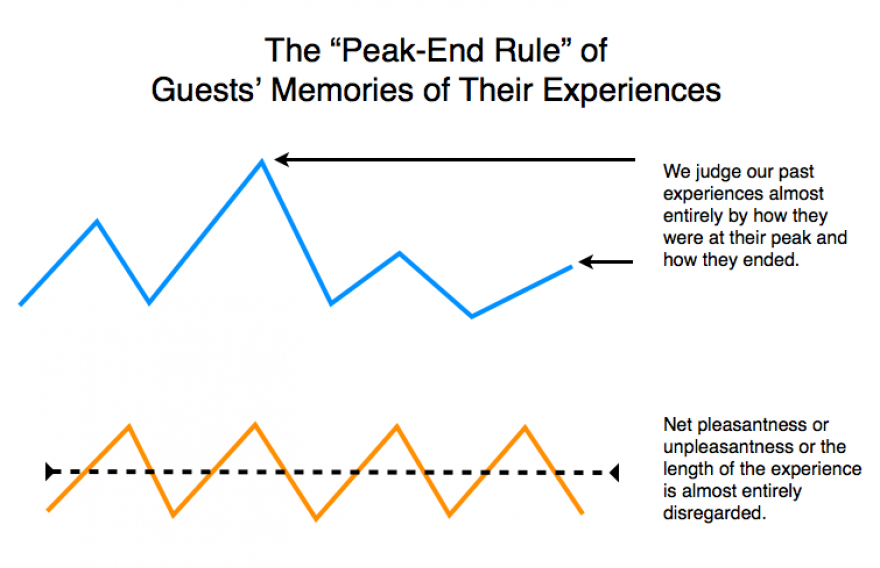
Vol. II, No. 4, August 2024
What shapes a positive memory of a visit to an agritourism farm
Many myths (now known as alternative facts) exist in the location-based leisure industry about what forms and shapes a positive memory of a visit. These myths, unfortunately, hinder agritourism venues from optimizing both the guest experience and guests' positive memories of their visit. One such myth is "first impressions count," which often leads operators to allocate excessive resources and effort to the design of the initial impression upon entering the farm or ranch in terms of the physical environment and operations. In the retail industry, think of the Walmart greeter as an example.
There is no doubt that first impressions are important. However, they begin long before actually entering the farm or ranch. They often start with the agritourism venue's website and online customer reviews. If these pass scrutiny, the next first impression occurs at the roadside front of the facility. The attractiveness of the parking lot and buildings can quickly determine whether passersby have a positive or negative impression of the business and whether they might consider visiting it.
First impressions can also set the mood for entering guests. However, the saying "first impressions count" seems to imply that they create a lasting impression of the visit after the guests have left. A psychological phenomenon in behavioral economics tells us that first impressions are not truly important in forming how people judge their experiences and their memory of the experience. Research shows that what is called the "peak-end rule" determines what we remember and how we judge an experience after it ends, whether positively, negatively, or not at all memorable. The peak-end rule suggests that our memory of an experience is not influenced by its beginning, duration, or overall intensity.
According to the peak-end rule, our memory of an experience is primarily determined at two critical points: the emotional peak, which represents the most intense or significant moment of the event (whether good or bad), and the ending, which captures the emotions felt as the experience concludes. These two aspects serve as a summary of our memory of how we thought about the experience. It is a shortcut the brain uses to form a long-term memory of the experience.
We do not remember or judge an experience based on the total sum or the average of every moment throughout its duration.

The peak-end effect states that when prioritizing a guest experience strategy, it is better to create a high emotional peak, an 'aha' moment, rather than trying to reduce the number of minor low moments. It is essential to ensure that first-time users experience a positive emotional peak, as they may not return if they only remember the low points.
When we recall an experience and how it made us feel, it turns out that its overall length is not important. What matters more is the intensity of the sensations, whether excitement, pain, or contentment. Moreover, people remember how they felt at the most intense moment and at the end of the experience. This is the essence of the "peak-end rule."
What truly matters in forming the memory of visiting an agritourism venue is the emotional intensity of the experience at its peak, combined with how guests feel at the end rather than the first impression. Even if a minor part of the experience is unpleasant, people may not remember it if the peak was good and the visit ended happily.
Usually, offering an excellent peak experience is not a problem for well-managed agritourism venues. The main attractions or experiences themselves can generate a positive peak experience. Of course, this depends on avoiding any unpleasant peak experiences. However, often, the end of the visit needs attention. Guests can become frustrated and annoyed if checkout involves a long wait. Re-engineering the checkout process can overcome these problems and create a positive end experience.
If dining is the last part of the visit, the perpetual wait for the check when the waitstaff seems to have disappeared can leave a negative last impression. Here, staff training becomes critical. Excessively long queues can also create a bad peak experience. The end of birthday parties can also be unpleasant if the experience is not adequately managed. Agritourism farms offering birthday parties should ensure that the end of the party's visit, especially for the birthday child and their parents, is a positive experience in order to leave an overall pleasant impression and a lasting memory.
Understanding and applying the peak-end rule is a powerful tool for farms and ranches to optimize guest satisfaction and create lasting positive memories. By strategically designing positive, memorable peaks, focusing on positive endings, and enhancing various experiential elements, agritourism venues can elevate the overall experience and leave guests with a strong desire to return and post positive social media reviews.
Subscribe to Agritourism Today



